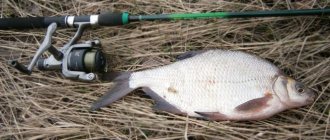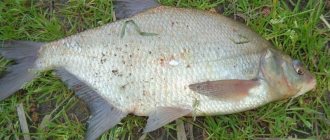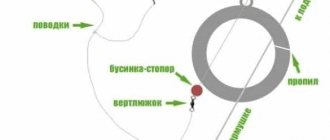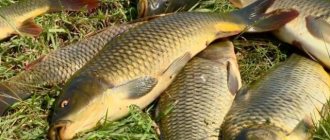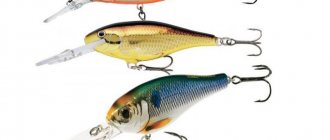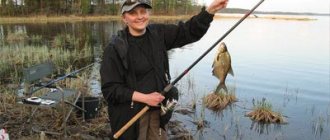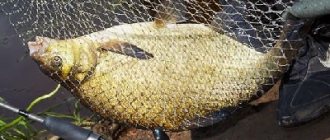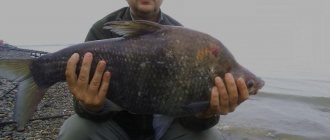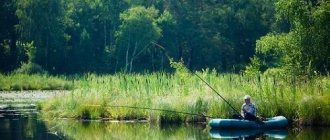In June, many river fish species become incredibly voracious. They have spawned and are now actively recovering their strength after a grueling spawn. This list also includes such a coveted trophy as bream.
Its spawning begins in the last days of May, it only takes a couple of weeks to procreate, and then the bite gradually improves, and from mid-June anglers again have the chance to have excellent fishing. With a competent approach to fishing, the right choice of place and gear, bream fishing in June gives good catches and a lot of positive emotions.
Bream behavior in July
In the hottest month of summer, the amount of oxygen in the water drops, which forces schools of bream and bream to go deeper in the hottest hours. There, cyprinids wait out the heat, practically motionless. However, with the onset of coolness, the appetite takes its toll, and the bream goes out in search of food.
Did you know? The name "bream" comes from the Slovak word "leskanje", which means "splash". The fish was named so for its habit of jumping out of the water during spawning and splashing back sideways with a loud splash.
In the evening and night hours, as well as in the early morning, schools of fish come closer to the shore, where they feed on invertebrate larvae, small insects and plants. This is where you can catch a full tank of hefty fish by choosing the right place for fishing, as well as suitable bait, bait or bait.
This is interesting: Bream fishing in summer
What are the advantages of fishing with a feeder in June-July?
At the beginning of summer, fishing with feeder gear is effective on any body of water. Basically, crucian carp stay away from the shore and only in the early morning or during the spawning period come closer to the reeds and snags.
Feeder gear is used for catching crucian carp during the day, when it is hot in the summer and it moves away from the shore
You won’t find it in shallow water at this time of year either – high water temperatures and low amounts of oxygen create uncomfortable conditions. Anglers are forced to look for fish at depth, and it is the feeder that turns out to be most useful.
This gear has many other advantages when fishing for crucian carp in June-July:
- Fishing with such gear allows you to eliminate the negative impact on the fish itself of loud sounds and noise coming from the shore. The bait is usually thrown at a distance of 50-70 m, where the depth is also several meters.
- Makes it possible to fish and feed different areas, and if there are no bites, quickly change the fishing location.
- In reservoirs where there are a lot of small fish, it helps to get rid of their bites. “Trifles” in the form of roach, bleak and small sorug often live near the shore, annoying floaters.
- The bait is washed out of the feeder much more slowly, thereby attracting fish longer and keeping it in one place at a specific point.
- When catching a large fish, the feeder, due to the properties of the inertia-free reel, allows you to confidently pull it to the shore, reducing the risk of the line coming off or breaking.
One of the advantages of feeder gear is the feeder, which increases the efficiency of bait
Useful tips
- If the place has been checked for a long time, but there was no bite in the morning, you should not rush home, the bream may show itself closer to lunch.
- In the morning and evening hours, you can determine the feeding areas of a school of bream by the bubbles rising to the surface. To do this, you just need to look carefully at the water.
- If the tackle is reliable, you should not stand on ceremony with the hooked fish. Once hooked, the bream begins to desperately resist, trying to “dive” under the nearest stone or insert the rig into thick grass. Forced fishing will help to avoid such trouble.
What to use as bait
Bream fishing in June is traditionally carried out using maggots or bloodworms (you can also use regular worms). In summer, breams can also bite on plant foods.
Most fishermen choose as bait:
- dry pearl barley;
- corn kernels;
- peas;
- semolina porridge;
- raw dough;
- boiled potatoes;
- pasta;
- bread crumb.
If fishing is carried out in a reservoir located near a village or any other residential area, the bite with standard bait can be very bad due to the fact that the fish will be fed. In this case, it is much wiser to prepare for fishing in advance and prepare a special bait.
The bait for bream, which is prepared as follows, has proven itself very well:
- first you need to put a small grain of corn on the hook;
- then attach the pasta to it (you need to choose a flour product that will definitely not disintegrate when it gets into water);
- the last ingredient is 2 maggots.
The amount of bait is selected depending on the size of the hook and how large the fish are in the pond. Many anglers also add various flavors to their baits to achieve maximum results.
If the product is chosen correctly, the fish may be even more interested in it than in live maggots.
What are the best baits to use?
3
To prepare bait for catching bream in June, you should use the following components:
- - the cake should be the basis,
- - you should add some pumpkin seeds,
- - in addition, flax seeds will attract this fish,
- - you can add a little hemp.
In addition, the basis of bait for catching bream in June can be homemade crackers and then crushed. This fish in no case tolerates the smell of moldy products.
If you are going fishing on rivers, then bait made from boiled pea porridge with the addition of oatmeal and a little clay has proven to be excellent. This fish prefers natural products and plant seeds to any artificial bait.
What does bream bite on in June, besides plant bait? You can also fish with a fishing rod using live worms or grasshoppers. Excellent for hooking dragonflies. In general, you can catch bream using regular bread. Just don’t use black bread, for some reason bream don’t like it, it’s better to take white bread. Bream may bite on pieces of meat or parts of a torn frog.
Where to look
Before you can catch any fish, you need to find it. Bream lives in almost all medium and large rivers of our country, as well as in many lakes and reservoirs.
On the river in June, the water, as a rule, subsides, and bream and bream tend to go deeper. In summer, bream fishing is carried out in pools, riverbed holes and edges. However, at night, bream rise to shallower areas of the river bed in search of food, where it is worth catching them, having identified such places in advance before dark.
In lakes, bream and bream look for food in thickets of aquatic vegetation on its borders with clean water. However, in deep reservoirs in shallow water, fish come out only at the end of daylight; at other times of the day, bream fishing in June is carried out in holes or edges.
Features of preparing tackle
It is recommended to catch bream in June using float and bottom fishing rods. Since the fish is mainly at depth, no wiring is carried out. A good effect is achieved by using donkeys with feeders and steamed peas as bait. You can catch bream using a float rod from a boat. But you should choose the right tackle:
Roach in June 2021: rules and features of fishing Fishing for crucian carp in June 2021: an unpredictable activity Catching perch in June 2021: an exciting and challenging activity Features of catfish fishing in June 2019
- the leash should be 0.15mm;
- fishing line - no thicker than 0.2 millimeters;
- elongated float.
The presented requirements must be observed, otherwise you simply will not see a careful bite of bream. The float will require several weights - one pellet for the leash and 3 pellets for weighting. It is quite easy to find out that a bite has occurred: the float moves to the side, or it lies on the water. The length of the rod when fishing from a boat should reach 4 m; for fishing from the shore, the tackle should be longer.
From the shore you can use a spinning rod with a feeder. It may be one of the following types:
- heavy – for 120-gram feeders, used on fast-flowing rivers;
- light - for 20-50 gram feeders, used in still water when casting 50 m or less;
- medium - for feeders weighing 80 g, used in rivers with medium flow.
The classification is based on bait, the weight of which is 15 g. Therefore, it is recommended to choose a feeder 20 g less so as not to damage the spinning rod.
This is interesting: Bream fishing in October
Search for a promising location
Half of the success of any fishing is achieved by how well we know the area of the reservoir and choose the right area in which we will fish. Therefore, let's look at the most catchy places for catching bream with a feeder on the river.
Places at the exit from the pit
These are exactly the places where bream most like to feed. After all, edible particles of food brought by the river current settle in them, and you can always find something for the bream to snack on. Why are the places at the exit of the pit promising? Because bream, as you know, is quite cautious and does not feel at all safe in the pit itself; having found food there, it immediately tries to get out of the pit to where there is a large space for escape. In addition, you need to take into account that the place of exit from the pit where you can find bream is located on the edge farthest from the shore, closer to the depth of the reservoir. It’s easier to “escape” from here and the food of interest to the bream is washed out here.
Edge edge
The brow is a small plain of a former river bed, which was formed due to the washing out of bottom soil by water. At this point, there is a high probability that fishing with a bream feeder will take place with a good bite, this is explained by the fact that under the influence of the underwater current various particles of food are thrown out here.
Terrace behind the edge
This place, like the previous two, is tempting for bream due to the movement of the water. In this place, like a sea surf, it creates a kind of whirlpool, hitting the edge. Thus, the food that has settled on the edge of the edge is washed off onto a flat terrace, and then carried back to the edge. This endless process is familiar to our predator and that is why he often sits here waiting for the next portion of food.
In addition to the topography of the bottom, the depth of the reservoir plays a significant role in the success of feeder fishing for bream. It all depends on the temperature of the water, which can change during the day under the influence of the rays of the sun, wind flow, rain and other natural phenomena, as a result of which the fish is in constant motion, swimming from one place to another: from shallow to deep and vice versa. So, for example, if we consider the intensity of bites on a not particularly hot summer day without rain and wind, then the most active bites will be in the daytime at a depth of about 7-12 meters, and at night - 2-4 meters. Less active, but also bream will bite at night at a depth of 7-12 meters, as well as day and night at a level of 4-9 meters from the surface of the water. A low frequency of bream bites is observed both at night and during the day at a shallow depth of up to two meters.
How to catch bream in June?
June is suitable for using almost any gear. This can be a float, wire or bottom fishing rod with a feeder. Among them, donka has become widespread at present.
Bream fishing gear
Float rod
A good float fishing rod is assembled from components according to certain rules:
- The required rod length must be more than five meters.
- The thickness of the fishing line is equal to 0.12 mm.
- The leash is chosen to be 0.01 mm thinner than the fishing line.
- The load should be such that you can notice the float raised by the bream.
Fishing with a float rod is carried out on lakes, reservoirs, and reservoirs with standing water. A small hook is selected for the tackle, and it is better to take a float of a dark color with an oblong long body.
Wire fishing rod
Fishing is carried out in the following way: on the surface along the flow of water, in the thickness or at the bottom, the fisherman holds the bait, thereby forcing the bream to grab it. This method is acceptable both in a boat and on shore.
Basic criteria for use:
- The most important factor here is the weak current.
- The reel of a wire fishing rod should be light with a sensitive float, so that it is convenient to observe from a long distance.
- An oval-shaped float with good load-carrying capacity and a bottom fastening is selected.
- It is very important to choose the correct distance between the float and the hook. Hook size from No. 5 to No. 8.
- The center of gravity in the rod should be on the side of the handle.
- The rod you choose is light and has a length of 2 to 3.5 m.
- The fishing line is strong, the weights are small.
Bottom fishing rod
A bottom fishing rod with a feeder is very popular among fishermen. This is called feeder fishing
. Advantages:
- Can be used in rivers with strong currents, standing reservoirs, at any depth.
- It is possible to cast bait and bait at a distance of 80-120 m.
- Provides constant feeding.
- The fish bite is determined visually, by sound or using electronic alarms.
Which baits are best for catching bream during the day, and which ones at night?
A universal attachment that can be used day and night, as well as a bunch of red worms at any time of the year. During the day, it is better to prick a lot of worms so that they intertwine. This creates an appetizing lump for the bream. The best bait during the day is sweet bread and other baked goods with the addition of anise or dill. At night, it is better to use a wormer, a wormer, or a crawler as a nozzle.
Fishing for bream at great depths and in various currents
At a significant depth with a medium to strong current, undercutting and ringing using attachments in the form of peas, bread crumb, a lump of porridge, a small cluster of worms, and a small amount of maggots will provide good service.
There is no need to rush into hooking because you need to let the bream swallow the bait and you need to wait for a good line tension. However, you cannot miss the moment of hooking due to the fact that bream rarely hook themselves. Only practice will teach you to reliably determine the right moment.
Don't forget about these circumstances:
- The bream will grab a small bait instantly.
- The voluminous nozzle will first be wetted.
- At night, bream is not so careful.
- A fed bream will not immediately grab even a small bait.
How to catch bream in June from a boat?
The surest way to stay with your catch is to use ring fishing. It is preferable to choose a rubber boat, because it is almost silent. You will need two anchors with a strong rope to hold the boat in the current. You can use one anchor, which will slightly turn the boat.
As soon as you swim in, you need to fill the feeder with bait and lower it to the bottom. The main food is porridge and crackers. A current is needed to wash the feeder. Otherwise, fishing will not take place.
On bodies of water without current
Here I can’t imagine successful fishing without a match fishing rod.
This tackle only at first glance seems overly complicated. In fact, you can only get to bream fattening in shallow water without making a noise with a match fishing rod. First of all, I choose for fishing the shallowest areas of reservoirs, where the bottom is most often covered with a dense carpet of grass. For a properly configured float tackle, this grass does not pose any danger, but it always contains a lot of slugs and other crawling creatures, for which the fish come here.
The second reason why bream prefer shallow water to deep water at the beginning of summer is warmer water. In shallow water, the water temperature is always several degrees higher than in the rest of the reservoir. It’s just that the water, which is still very clear, places special demands on the fisherman. To prevent the fish from feeling suspicious, stealth is extremely important. That's why I prefer a match fishing rod to all other gear. A small float is much less alarming to the fish than a feeder or a heavy bottom sinker. And there is no need to cast the equipment far at the beginning of summer. I have caught fish at a depth of no more than a meter, almost right at my feet.
Sometimes you can catch bream even with visual contact. This is the highest degree of bliss. Imagine, you suddenly notice that large shadows begin to move near the spot of bait on the bottom. Now the fish begin to rummage in the ground, raising mud around them. With fingers numb from excitement, you squeeze the rod tighter. Now the bream begin to rummage in the immediate vicinity of the bait. Trembling appears in your hands, and your heart begins to beat even faster. You wait with bated breath for the outcome. For a few seconds, the whole world around you freezes. And now the antenna of the float slowly creeps up... Only match fishing in the shallows at the beginning of summer can be so exciting.
Powerful tackle
Archive photo
Since in shallow water you are always waiting for a bite from a large fish, and the space around is replete with all sorts of obstacles, the rod must have a sufficient reserve of power.
I don't use rods shorter than 3.9 meters and weight less than 25 grams. It’s good if the rod’s action is parabolic. This gives me an additional advantage, since such rods are better at tying up fish when playing. The diameter of the main line must be at least 0.18-0.2 mm. Rough? Yes! But if the fish immediately after hooking jumps into the grass and breaks the tackle there, the fishing will most likely be ruined. Light float
But the float for shallow fishing should be light. My gear has floats with a narrow body with a carrying capacity of only 2-3 grams. Classic match floats with a carrying capacity of 6 grams or more make noise when casting like a feeder and are ineffective when stranded. And the actual length of these floats is large. At a meter depth, such a float looks like a buoy, which also alarms the fish.
Which float to take - fixed or sliding - depends on the specific fishing conditions and the mood of the fish. I prefer to fish with fixed floats, but when the rig has to be cast into the wind, it is better to fish with a sliding float. For additional camouflage of gear, I often use transparent Drennan Puddle Chucker floats 2.5+0.5 grams.
Multi-point loading
For shallow fishing, a multi-point load consisting of at least 3 weights is best suited. This allows me to achieve the most accurate immersion of the bait. The leash must be short, no more than 10 cm. Otherwise, the bite “on the rise” is very difficult to detect.
Hook according to bait size
It is very important to choose the right hook size. It must fully match the size of the nozzle. A hook that is too small will not hook the fish well, and on a large hook the delicate bait will be dented even when hooked. Since in June shallow fish feed on all kinds of insects, bulky baits in the form of corn grains are not very popular here. I usually fish for one or two maggots, half a dung worm or shite. Accordingly, I choose hook No. 12-14. Definitely made of thick wire. When landing fish in the shallows, the hook experiences enormous loads, and if it “plays”, it cannot be avoided.
Loose bait
When shallow, the fish behave cautiously, and excess noise only spoils the fishing. Therefore, I use vegetable bait molded into balls only at the very beginning, when I want to designate the fishing point. And even then I use exclusively a crumbly mixture, which breaks when it hits water. A column of turbidity settling in the water is visible from afar. Starter bait always contains a large number of dead maggots and overripe casters. This gives the bait the necessary nutritional value and activity. Uncrushed casters constantly float in the water and thereby attract fish even more to the bait. The color of the bait must be dark: black or brown.
In the future, in order not to alarm the fish with unnecessary noise, I support its appetite only with the help of chopped worms, maggots, casters and canned corn. I chop the corn very carefully. It is important that its size is smaller than the size of the nozzle used. Otherwise, there is a high probability that the fish will switch to eating bait. It is most convenient to throw such bait from a slingshot.
Nozzles
Since shallow fish feed exclusively on animal food, it is most profitable to offer them animal baits. If there is an opportunity to collect shitfish or large dragonfly larvae, this will be a win-win option. June is the time of pupation and emergence of many insects. This natural food is readily eaten by fish. And during moments of mass emergence of dragonflies or mayflies, it does not feed on anything else.
In second place in popularity are maggots. Bream are very fond of this all-season popular bait, but there is one important feature that for some reason many anglers do not pay attention to. There is no need to collect larvae in large bunches, as is done in July or August. The fish are more likely to be tempted by one or two larvae, presented so that they look as if they have just crawled out of the bait. Next come pieces of earthworms. At the beginning of summer, dung worms, beloved by many anglers, look good in bait. They exude a special aroma that fish like, but they prefer to eat torn earthworms. Sometimes casters work well.
All of the above tips can be served either pure or in sandwiches. But at this time I try to leave the plant attachments at home. Although steamed grains are always present in bait. Their presence at the fishing point guarantees me that the fish will stay here for a longer time.
Fishing from the shore
If a person is really passionate about fishing and spends several days a week doing this activity, it is recommended to find a natural feeding area for the fish. Most often, its role is played by areas overgrown with reeds and various bays.
A fisherman can choose virtually any tackle as a fishing rod, but his main tasks will be:
- maintaining complete silence;
- good camouflage.
Everyone knows that bream is an extremely cautious fish and if it sees something alarming, it simply will not swim up. Also, in order to increase the likelihood of a catch, the fisherman needs to study the habits of carp fish.
If you have no experience, it is better not to take risks and go fishing at night, when fish activity increases several times. After midnight, regardless of the weather, the bream will in any case go out into shallow water to search for worms and bloodworms.
But to be on the safe side, it is still recommended to scatter a small amount of bait in the selected location. The best option is to mix the cake, bread crumbs, a little granulated sugar and vanillin. All ingredients need to be mixed, rolled into small balls and thrown into the chosen fishing spot.
We successfully catch crucian carp in June on a feeder
The first month of summer is often the best time to catch crucian carp. The fish is running out of eggs and all its thoughts are now only about feeding intensively. In addition, at this time the weather improves in almost all regions. This means that changes in atmospheric pressure will not affect the activity of crucian carp.
What else does June contribute to a good bite? Firstly, many reservoirs have stable water levels. If in the spring lakes and rivers flood widely as a result of melting ice and snow, now they are returning to their usual course. The fish feels good both in shallow waters and at depth. Secondly, a comfortable water temperature is established, and there is no lack of oxygen in it, which often happens in the middle of summer. Thirdly, aquatic vegetation has not yet appeared, which can both cause a snag and simply hide the bait from the fish.
You can successfully fish on a feeder in June from morning to evening. Moreover, if during the day the number of bites on a float rod decreases sharply, then on long-casting gear the fish continues to bite.
The effectiveness of fishing with a feeder is due to the fact that crucian carp, due to warm weather, stays further from the shore and fishing with a rod is not effective
This is explained by the fact that it retains an increased appetite after spawning, but it is not always able to feed in the coastal part due to the high water temperature.
However, you need to remember that crucian carp actively moves throughout the entire reservoir in the first month of summer. It is often difficult to keep him in one place even with the help of well-balanced complementary foods. Therefore, if there are no bites, try fishing other areas, throwing the bait at different distances, including closer to the shore (15-30 m from it). Convenient if you fish with several feeder gear at the same time. Then each of them can be thrown at a different distance and the optimal point can be found faster.
June is a great time for feeder fishing. Catching crucian carp with such gear is almost always effective at the beginning of summer. The main thing is not to be afraid to experiment with baits and complementary foods. Only changeable weather can prevent you from catching fish, but for warm June days this is the exception rather than the rule.
Because crucian carp often moves in June, the use of several feeders will increase the chances of catching
Fishing from a boat
Since after midnight the bream begins to walk throughout the reservoir, it is much wiser to fish by boat, so the fisherman will be able to get to the most inaccessible and attractive places. It is best to stop near the reed bushes, as dense vegetation will camouflage the fisherman.
It is better to fish from a boat with the following gear:
- float rod;
- donka with jig;
- wire rod.
It is very difficult to say what is best to use as bait for such fishing, since bream will most likely bite both live bait and plant bait. Experts assure that the optimal weather for catching bream is calm and stable. If over the past few days the weather conditions have not changed at all, and the atmospheric pressure has remained at the same level, the bream will bite well both in the heat and in the cool.
Similar articles
Secrets of catchy places for catching bream in September using a feeder and float
DIY bait for bream recipes
Bream fishing
What hooks are needed to catch bream?
Catching bream on a feeder
So, after you have chosen a promising place for fishing and laid out all the necessary gear, you should start preparing bait. The bait for bream on the feeder should be aromatic, tasty and, most importantly, there should be a lot of it.
Bream loves to eat, and in order to lure it to the fishing spot, and most importantly, keep it, the bait must be of high quality. It should contain a minimum amount of large particles that could quickly saturate the bream.
It is best to make fine-grained bait, or even better, sift it through a sieve. You can make feeder bait for bream yourself, or you can save time and simply buy it at a fishing store. Fortunately, there are a lot of bream feeder baits, and the choice of flavors is practically unlimited.
In the summer, using feeder equipment, it is worth trying bait with the smell of garlic, strawberries and even plums. When mixing feeder bait, add water in small portions so as not to over-wet it. The bait for bream should stay well in the feeder, reach the bottom, and quickly wash out from there, thereby creating a feeding path and a feeding spot.
